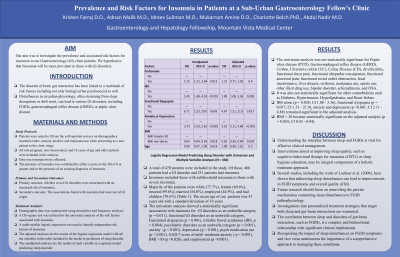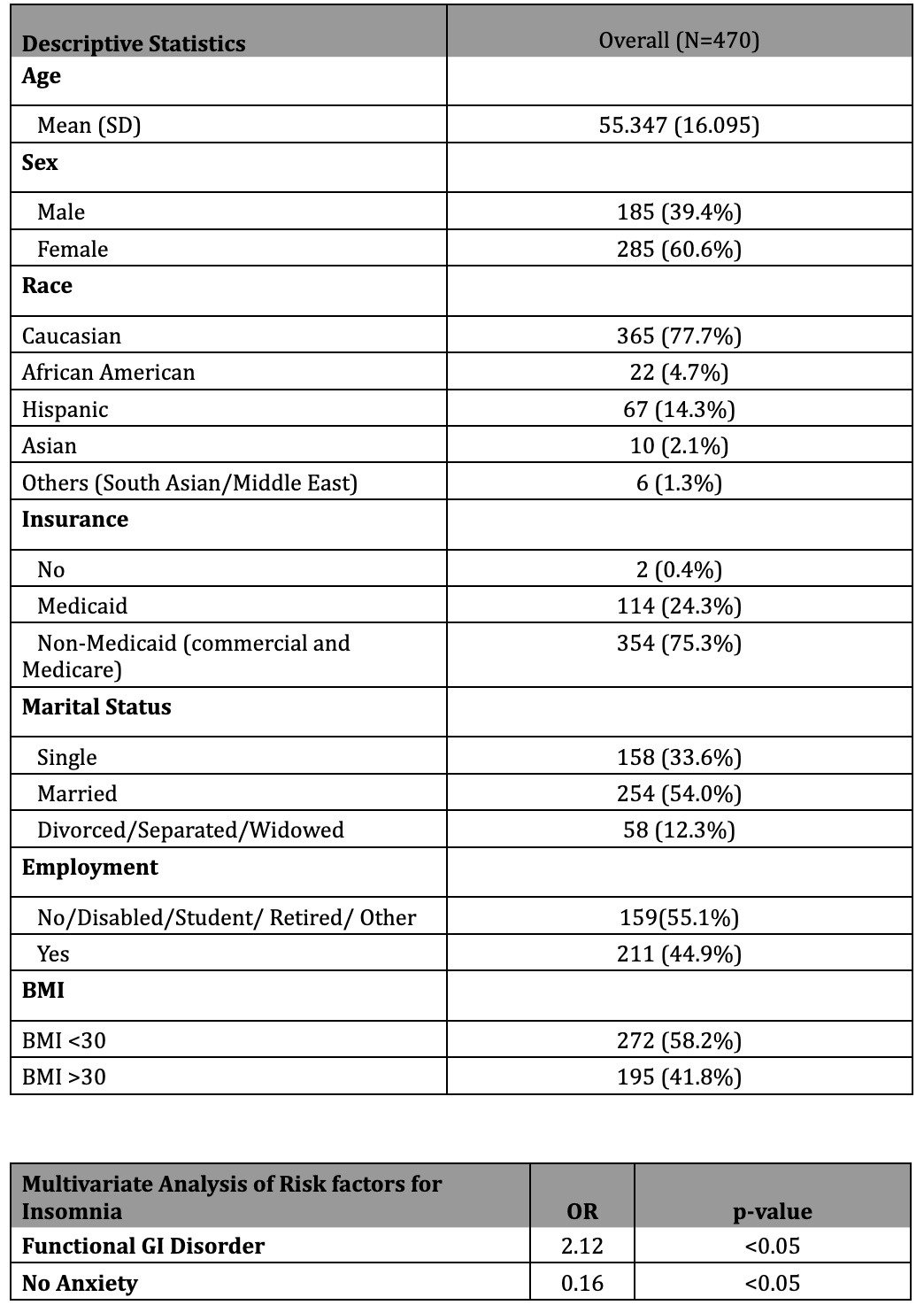Sunday Poster Session
Category: Functional Bowel Disease
P0530 - Prevalence and Risk Factors for Insomnia in Patients at a Sub-Urban Gastroenterology Fellow’s Clinic
Sunday, October 22, 2023
3:30 PM - 7:00 PM PT
Location: Exhibit Hall

Has Audio

Kristen Farraj, DO
Midwestern University
Chandler, AZ
Presenting Author(s)
Kristen Farraj, DO1, Adnan Malik, MD2, Idrees Suliman, MD2, Mukarram Amine, DO2, Charlotte Bolch, PhD3, Abdul Nadir, MD4
1Midwestern University, Chandler, AZ; 2Midwestern University, Mesa, AZ; 3Midwestern University, Glendale, AZ; 4Mountain Vista Medical Center, Mesa, AZ
Introduction: Insomnia is associated with poor health outcomes. Neurohormonal feedback of the Gut-Brain Axis can affect the circadian rhythm and sleep regulation. We aim to investigate the prevalence and associated risk factors for insomnia in our Gastroenterology (GI) clinic patients.
Methods: Self-reported surveys on demographics, insomnia index, anxiety, alcohol, and marijuana use were filled out by patients presenting to the clinic triage. Data was retrospectively collected by GI-fellows from the EMR, utilizing Excel software. All non-pregnant, non-incarcerated, and 18 years of age and older patients were included in the analysis. Demographic data was summarized using descriptive and frequency statistics. A Chi-square test was utilized for the univariate analysis of the risk factors associated with insomnia. A multivariable logistic regression analysis was conducted to identify independent risk factors of insomnia.
Results: A total of 470 patients were included in the study from November 2022 to April 2023. 231 (49.1%) patients were found to have insomnia based on the Insomnia Severity Index and/or EMR diagnosis. The mean age was 55 years, 365 (77%) were Caucasians, 254 (54%) were married, 211 (44.9%) were employed, 354 (71%) has commercial/Medicare insurance, 195 (41.8%) had BMI ﹥30 and 28 (6%) were diagnosed with Alcohol Use Disorder based on the alcohol screening questionnaire, 173 (36%) had Clinical anxiety (GAD >1) per Generalized anxiety disorder (GAD) questionnaire and 71 (15%) patients had marijuana use disorder. On Multivariate analysis, odds for insomnia were significantly higher in patients with FGDs compared to the non-functional GI disorders (OR: 2.12, p-value < 0.05). The odds for insomnia were significantly lower in patients without anxiety compared to patients with a diagnosis of anxiety or GAD score greater than 1 (OR: 0.16, p- value < 0.05).
Discussion: Our study highlights the demographics and clinical characteristics of patients endorsing insomnia. Lack of sleep has been associated with FGD. Our data provides further insight into the characteristics of patients with insomnia, seen in a sub-urban GI-clinic. A multipronged approach delivered by a team of psychiatrists, behavioral therapists and gastroenterologists can provide optimum care to patients in GI clinics.

Disclosures:
Kristen Farraj, DO1, Adnan Malik, MD2, Idrees Suliman, MD2, Mukarram Amine, DO2, Charlotte Bolch, PhD3, Abdul Nadir, MD4. P0530 - Prevalence and Risk Factors for Insomnia in Patients at a Sub-Urban Gastroenterology Fellow’s Clinic, ACG 2023 Annual Scientific Meeting Abstracts. Vancouver, BC, Canada: American College of Gastroenterology.
1Midwestern University, Chandler, AZ; 2Midwestern University, Mesa, AZ; 3Midwestern University, Glendale, AZ; 4Mountain Vista Medical Center, Mesa, AZ
Introduction: Insomnia is associated with poor health outcomes. Neurohormonal feedback of the Gut-Brain Axis can affect the circadian rhythm and sleep regulation. We aim to investigate the prevalence and associated risk factors for insomnia in our Gastroenterology (GI) clinic patients.
Methods: Self-reported surveys on demographics, insomnia index, anxiety, alcohol, and marijuana use were filled out by patients presenting to the clinic triage. Data was retrospectively collected by GI-fellows from the EMR, utilizing Excel software. All non-pregnant, non-incarcerated, and 18 years of age and older patients were included in the analysis. Demographic data was summarized using descriptive and frequency statistics. A Chi-square test was utilized for the univariate analysis of the risk factors associated with insomnia. A multivariable logistic regression analysis was conducted to identify independent risk factors of insomnia.
Results: A total of 470 patients were included in the study from November 2022 to April 2023. 231 (49.1%) patients were found to have insomnia based on the Insomnia Severity Index and/or EMR diagnosis. The mean age was 55 years, 365 (77%) were Caucasians, 254 (54%) were married, 211 (44.9%) were employed, 354 (71%) has commercial/Medicare insurance, 195 (41.8%) had BMI ﹥30 and 28 (6%) were diagnosed with Alcohol Use Disorder based on the alcohol screening questionnaire, 173 (36%) had Clinical anxiety (GAD >1) per Generalized anxiety disorder (GAD) questionnaire and 71 (15%) patients had marijuana use disorder. On Multivariate analysis, odds for insomnia were significantly higher in patients with FGDs compared to the non-functional GI disorders (OR: 2.12, p-value < 0.05). The odds for insomnia were significantly lower in patients without anxiety compared to patients with a diagnosis of anxiety or GAD score greater than 1 (OR: 0.16, p- value < 0.05).
Discussion: Our study highlights the demographics and clinical characteristics of patients endorsing insomnia. Lack of sleep has been associated with FGD. Our data provides further insight into the characteristics of patients with insomnia, seen in a sub-urban GI-clinic. A multipronged approach delivered by a team of psychiatrists, behavioral therapists and gastroenterologists can provide optimum care to patients in GI clinics.

Figure: Descriptive Statistics and Multivariate Analysis of Risk Factors Associated with Insomnia
Disclosures:
Kristen Farraj indicated no relevant financial relationships.
Adnan Malik indicated no relevant financial relationships.
Idrees Suliman indicated no relevant financial relationships.
Mukarram Amine indicated no relevant financial relationships.
Charlotte Bolch indicated no relevant financial relationships.
Abdul Nadir indicated no relevant financial relationships.
Kristen Farraj, DO1, Adnan Malik, MD2, Idrees Suliman, MD2, Mukarram Amine, DO2, Charlotte Bolch, PhD3, Abdul Nadir, MD4. P0530 - Prevalence and Risk Factors for Insomnia in Patients at a Sub-Urban Gastroenterology Fellow’s Clinic, ACG 2023 Annual Scientific Meeting Abstracts. Vancouver, BC, Canada: American College of Gastroenterology.

